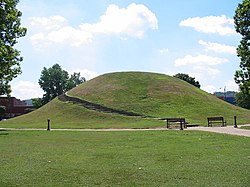Criel Mound
|
South Charleston Mound
|
|

The Criel Mound
|
|
| Location | US 60 (MacCorkle Avenue), in city park, South Charleston, West Virginia |
|---|---|
| Coordinates | 38°22′7″N 81°41′48″W / 38.36861°N 81.69667°WCoordinates: 38°22′7″N 81°41′48″W / 38.36861°N 81.69667°W |
| Area | 1.5 acres (0.61 ha) |
| NRHP Reference # | 70000655 |
| Added to NRHP | October 15, 1970 |
The Criel Mound is a Native American burial mound located in South Charleston, West Virginia, USA. The mound was built by the Adena culture, probably around 250–150 BC, and lay equidistant between two “sacred circles”, earthwork enclosures each 556 feet (169 m) in diameter. It was originally 33 feet (10 m) high and 173 feet (53 m) in diameter at the base, making it the second-largest such burial mound in the state of West Virginia. (The Grave Creek Mound in Moundsville is the largest.) The Criel Mound is located at 38°22′8.0″N 81°41′48.2″W / 38.368889°N 81.696722°W. This archaeological site is listed on the National Register of Historic Places.
The mound was originally conical in shape. Residents of the area leveled the top in 1840 to erect a judges' stand, as they ran horse races around the base of the mound at the time.
The Criel Mound was excavated in 1883–84 under the auspices of the US Bureau of Ethnology and the supervision of Col. P.W. Norris. The excavation was performed by Professor Cyrus Thomas of the Smithsonian Institution. Inside the mound, Professor Thomas found thirteen skeletons: two near the top of the mound, and eleven at the base. The skeletons at the base consisted of a single very large but badly decayed skeleton at the center, a "once most powerful man" which according to A.R. Sines who assisted Col. Norris in the excavation, measured "Six feet, 8 3–4 inches" (205 cm) from head to heel with broad shoulders, massive teeth and a very thick low and flat skull encased in a large copper headband. This skeleton was surrounded by ten other skeletons arranged in a spoke-like pattern, with their feet pointing toward the central skeleton. The skeletons at the base had been wrapped in elm bark and were lying on a floor of white ash and bark. Several artifacts were found buried with the skeletons, including arrowheads, lanceheads, and shell and pottery fragments. The central skeleton was accompanied by a fish-dart, a lance-head, and a sheet of hammered native copper near the head. Holes found at the base of the mound suggest that the bodies at the base had been enclosed in a wooden vault.
...
Wikipedia


